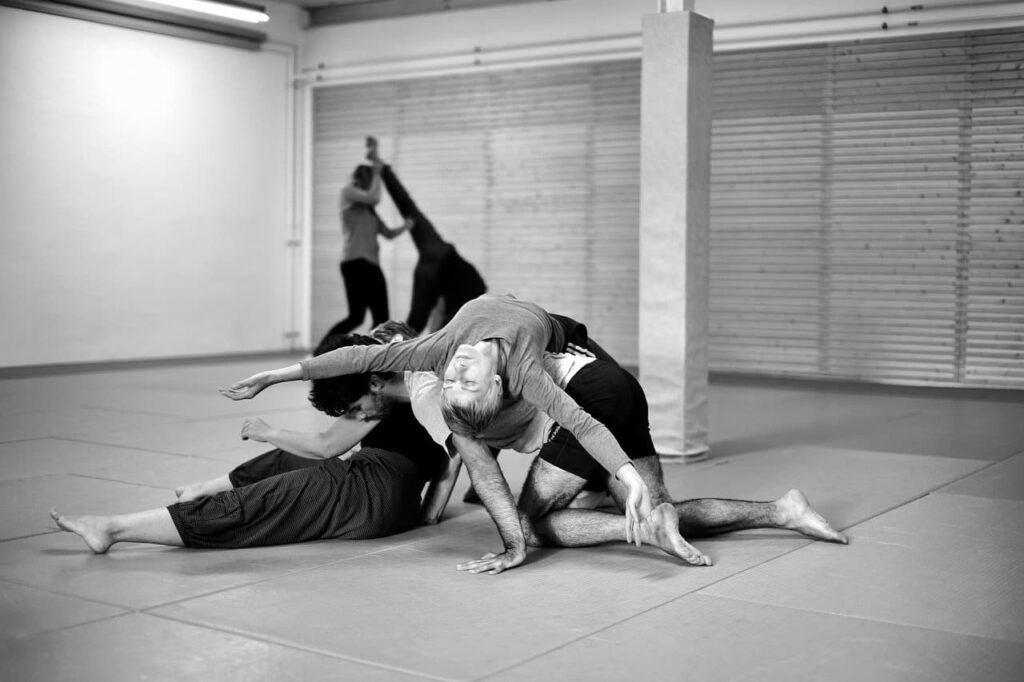
Last Thursday, the Contact Improvisation class hosted a Contact Dance Workshop. Zoe Chin ’26 and other students from the class opened the workshop by introducing what contact improv is.
“We’re excited to share our journey that we’ve been exploring, and now we get to show the super awesome cool stuff that Eric Nordstrom has taught us throughout the semester,” Chin said.
Contact improv is a dance form which was created in 1972 by Steve Paxton while he was a visiting artist in residence at Oberlin College.
“(Contact improv) has been built on and explored by many different dancers across the world and has kind of become a global movement. It’s still a newer dance practice, but we’re here exploring it and shaping it into what it is,” Chin said.
This workshop was part of that exploration, welcoming students curious about contact improv to experience it and bring their unique movements to the dance floor.
Sequoia Snogren-Mcginnis ’26 told us to listen to our bodies and how they wanted to move. She emphasized that any way participants showed up to the class was valid and important.
After a quick warmup stretch circle, the dancing began. The accompanist, Dylan Rieck, struck a few notes on his cello. Throughout the workshop, Rieck provided solo cello music which flowed between different moods and levels of tension and energy.
Participants moved around the room, weaving around one another and flailing their limbs, sometimes in rhythm with the music and sometimes not. Many people moved spontaneously in ways which flowed together in a seamless undulation. This natural control of their bodies impressed me as I awkwardly began to try to imitate movements that I saw.
At intervals, members of the class would give verbal guidance or instructions while continuing to move through the room with us. One person told us that stillness is also dance, and that it was okay to find moments of stillness within the movement.
Another student prompted us to explore how close we could get to other people’s bodies without actually making contact. Then, they had us explore how far away we could get from other bodies in the room. The students encouraged us to mirror others’ movements and join together in dual movement with those we noticed mirroring us.
From here, the workshop moved into exploring the contact aspect of contact improv. We were encouraged to sit, lie or kneel on the ground and find a partner to lean against. They encouraged us to feel our breaths interacting, and to begin to allow an interplay of our weights against each other.
The class’s teacher, Visiting Instructor Eric Nordstrom, invited me to be his partner since I was a newcomer. We sat with our backs against each other and moved without talking, forcing us to communicate movement nonverbally, by shifting our weights and moving our limbs around. Gradually, we began to roll around on the floor and rest our weights on top of each other.
After a while of exploring this partner movement, the facilitators prompted the pairs to reach out to other pairs and begin making connections with more people. Tangles of bodies swelled together and morphed; connections formed, broke and reformed within the groups spread across the floor.
The class culminated in all participants joining together to form one giant body sculpture, with everyone draped over each other and supporting one another’s weight in many different creative ways. The cluster of bodies was organic and dynamic. Chin added the finishing touch by jumping on another student’s shoulders and striking a pose.
The workshop was a unique experience and one that could only be had at an experiential liberal arts college such as Lewis & Clark. The energy between participants was palpable as we broke through the intangible boundaries of personal space. Though I have had similar experiences of energy and contact in mosh pits and at shows, I can truly say that I had never made contact with strangers with the kind of intentionality and awareness that contact improv demands.
Subscribe to the Mossy Log Newsletter
Stay up to date with the goings-on at Lewis & Clark! Get the top stories or your favorite section delivered to your inbox whenever we release a new issue.

Leave a Reply